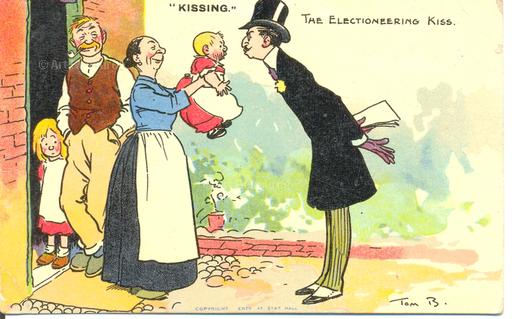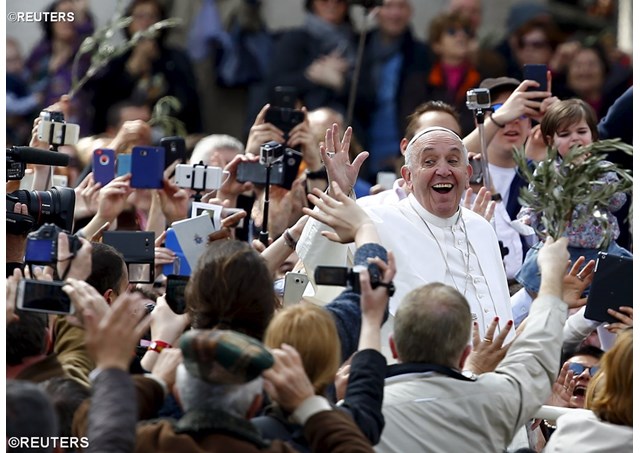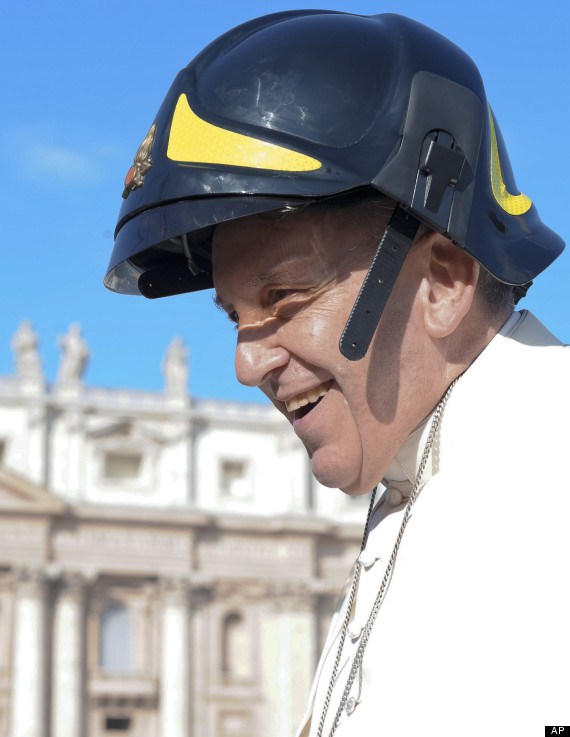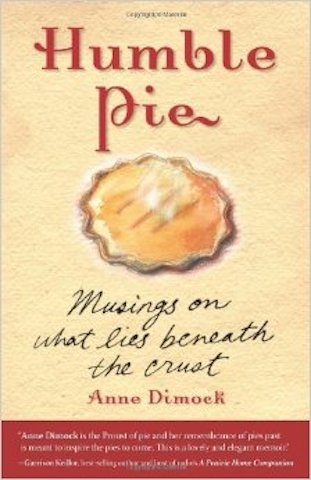Flannery O’Connor said it first: “Stupidity and vulgarity are harder to put up with than sin, harder on the nerves.” Therein is one reason Pope Francis is so irritating. By no means can any man who ascends to the Chair of Peter be faulted for stupidity. But one who pants after personal popularity as Francis does opens himself to the charge of vulgarity.
Vulgarity is a roomy concept. It covers more than crude language and slack manners. Showing off, too, is vulgar. Image mongering, a species of exhibitionism, is inherent in a media-saturated age. Like a politician on the stump, Francis has been crafting his image since white smoke went up the Vatican chimney.
Catholics have grown accustomed to—not to say dependent on—plebeian gestures by their popes, with certain higher clergy following suit. Few can remember a pontificate that kept its distance from the clamor and expectations of celebrity culture. One that avoided mass-mediated charades of commonality with the anonymous multitudes has faded into the mists of the pre-television era.
Church historian H.J.A. Sire writes of the enslavement of the contemporary papacy to contemporary opinion, tracing captivity to the Second Vatican Council:
The thralldom to popularity has been the taint of all the popes since the Council, marking them off from the security and authority with which previous popes taught and ruled. John XXIII should not really be included in the fault, for his popularity was a personal gift rather than something he sought after. But he set his successors an example to which they have all submitted. In Pope Francis the weakness has become a defining personal foible.
But it is more than a mere foible. It is a technique, a demagogic tool to draw allegiance to oneself and blur critical differences between office and office holder. Popularity permits an assumed personality—a stage image—to triumph over substance. Gresham’s Law kicks in. Amiable gestures drive out distinctions between crowd-pleasing geniality and the granite of pastoral purpose. Ultimately, the quest for popularity ends in crises of authority. And Church governance devolves into a kind of performance art.
Classic vulgarians are easy to spot; inverted ones, not so much. Standard types are not calculating in their displays of wealth. Ostentation comes to them naturally. Inverted ones, on the other hand, go about conspicuous displays of humility with intent. To appear humble in spirit and contrite of heart is a source of pride. Their apparent humility elevates them above the aspiring classes. In the grip of amour propre, pride turns turtle, flips upside down, and comes to look like its opposite. Premeditated shows of modesty create an impression of the vulgarian-in-reverse as meek and unassuming.
It is a mirage. In reality, papal pretense of being one with the masses is as vulgar as exhibiting your net worth on an LED board on the front lawn. Nevertheless, people fall for it. It has certainly worked for Francis. Going by Sandro Magister’s January 12th post “Francis Goes House-Hunting in Guidonia,” we could be due for yet another application of a winning formula.
Of the more than 300 parishes in the diocese of Rome, the pope has visited only twelve of them. So why a visit to Santa Maria a Setteville? The parish is within the diocese of Rome but outside its municipal territory. It lies instead within neighboring Guidonia Montecelio. Magister writes:
Eleven of the fourteen parishes of Guidonia belong to the diocese of Tivoli, and three of the diocese of Rome. And Pope Francis has already visited one of these three, that of Santa Maria dell’Orazione, on March 16, 2014, and now he is preparing to visit another. Two out of three.
The question arises: what makes Pope Francis want to go there in particular?
Magister continues:
Last June the Argentine archbishop Víctor Manuel Fernández, Jorge Mario Bergoglio’s trusted theologian and influential adviser, said in an interview with Religión Digital that “the pope does not necessarily have to live in Rome all the time,” because he is also “supreme pastor of the whole Church.”
But even in his capacity as bishop of Rome, he added, “there is nothing to stop him from going to live in Guidonia Montecelio,” which is another municipality but is still part of his diocese.
That’s right: Fernández singled out Guidonia as a possible place for the pope’s residence. Not the Vatican, not the city center, but one of its extreme peripheries, one of those “geographical and existential peripheries” so dear to Bergoglio.
An imagination more sober than Fernández’ might have gone looking for the periphery in southern Italy, the land of malasanitá, with its high rates of poverty and inadequate health care. But kabuki theater—Magister uses the word stunt—is a stylized production, as feasible as World Youth Day. Just the sort of thing to appeal to a theologian with a bent for camp. (Fernández, remember, was the author of Heal Me With Your Mouth: the Art of Kissing. I talked a bit about it [5]previously.)
Periphery is a wonderfully evocative abstraction. It conjures up far-flung, desolate places: Vostok Station in Antarctica, or the dunes of an unmapped desert. It leads to somewhere untouched, reachable only by satellite or prayer: the metaphoric summit of Mount Carmel, perhaps. Or Point Nemo, the absolute center of nowhere, a notional dot in the South Pacific with coordinates on the far side of beyond. But a 31 km. spin up A24 from Vatican City to Guidonia?
Just how existentially peripheral is this crowded bedroom town of some 80,00+ people on the northeast edge of metropolitan Rome?
A Lancia will get you there from Fiumicino, one of Europe’s busiest international airports, in roughly half an hour. The town boasts a four-star hotel, with four others less than 4 km. away. Nearby is the Marco Simone Golf & Country Club, scheduled to host the Ryder Club Match in 2022. You can view the dome of St. Peter’s from several spots on the green.
Tourists come to Guidonia to visit Roman and medieval landmarks, or the acque santissime celebrated for curative properties since ancient times. A crumbling trail of Fascist architecture runs through town. Here is the Foro Mussolini (now Foro Italico), a sports stadium touted for the largest mosaic plaza built since the fall of Rome and marking Italy’s conquest of Ethiopia in 1936.
Most notably, Guidonia is Italy’s Cape Canaveral. Named after General Alessandro Guidoni—hero, pilot, engineer—it was one of those new communes established on the reclaimed Pontine Marshes in service to Mussolini’s ideas of a Fascist romanità. Il Duce broke ground for it in 1935 with an axe, central to the fasces and symbol of Fascist demolition of the old order. Dedicated to aeronautics, Guidonia was Mussolini’s “city of the air,” replete with testing facilities, a military air base, and a world-class observatory that leads in asteroid discoveries.
The township also houses a major industrial complex. Its cement works are crucial to the Italian construction industry, as are the travertine caves that supply limestone to builders. (Material for Bernini’s colonnade in St. Peter’s Square came from here.)
So, Friends, not even in the most fanciful allegorical terms can Guidonia serve as emblem for the margins of the world.
What is Fernández playing at?
• • • • •
It would not be unlikely for Francis to be eyeing a superaddition to his image as a man sloughing off the pomp of centuries. He has taken a similar symbolic route before. His decision to leave the old papal apartments for a large, imposing modern suite on his own floor in Casa Santa Marta was greeted with reverence. Here, finally, was a plain servant whose foot was on the straight way. The press genuflected as it was meant to do.
Does the hour cometh to try it again? Magister suggests it might: “Musing over places of residence for the pope and the curia is a favorite maneuver for Fernández . . .”
Why? To what purpose this provocative musing by the pope’s long-time compatriot? Is it meant to deflect attention from such substantive matters as the unanswered dubia, and the reasoning behind Vatican outreach to Paul Ehrlich, the population prophet discredited by reality ? Or are these real estate ponderings no more than an idle tease?
The devoted Tucho Fernández, ghostwriter and confidante, is a worrisome presence in this pontificate. Perhaps time is past for the niceties of fraternal correction. A determined intervention might be more in order.
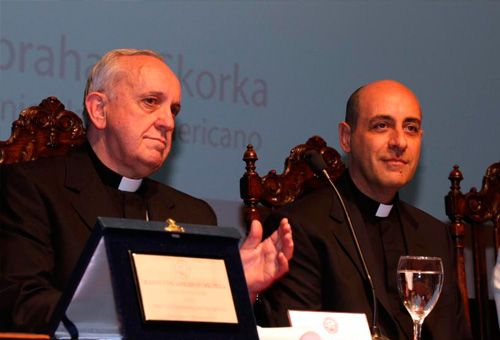 [6]
[6]
Note: Appearing in Crux, on January 15th, is an article by Michael Pakaluk, a professor of ethics at Catholic University of America. It raises vexing questions about Fernández’ role in the tenor of Francis’ reign. In Pakaluk’s dissection, Francis has lifted passages whole hog from the archbishop’s earlier writings without attribution. Charges of plagiarism are offset here by the fact that the appropriations come with Fernandez’ approval. Nevertheless, Pakaluk finds the nature of the unacknowledged borrowings problematic in themselves.
Read Pakaluk’s analysis [7]. It is followed by Fernández’ response, submitted at the request of Crux editors.
